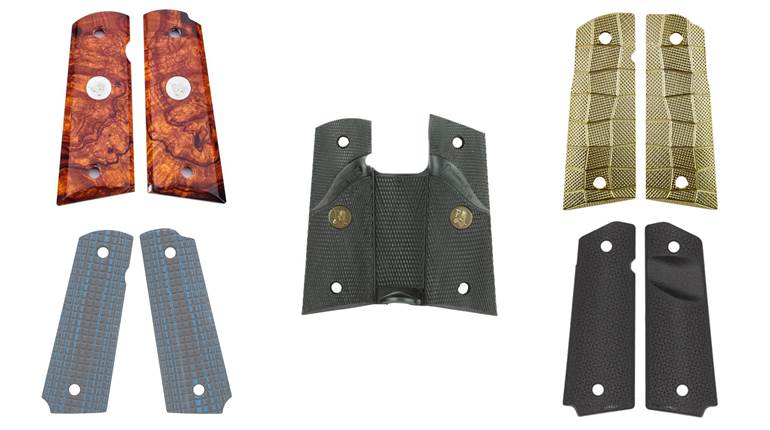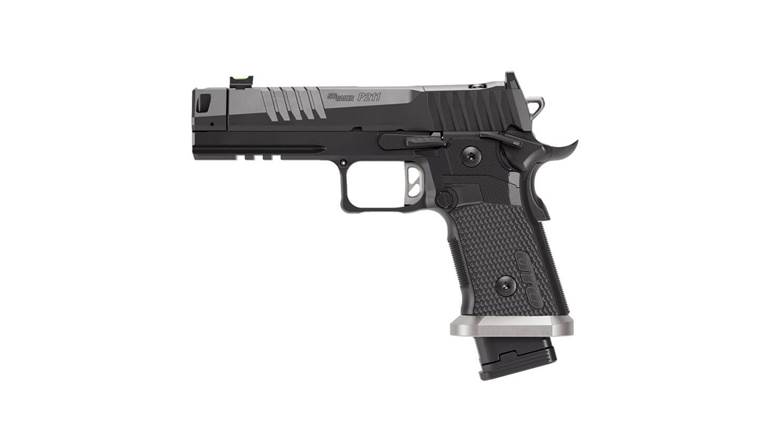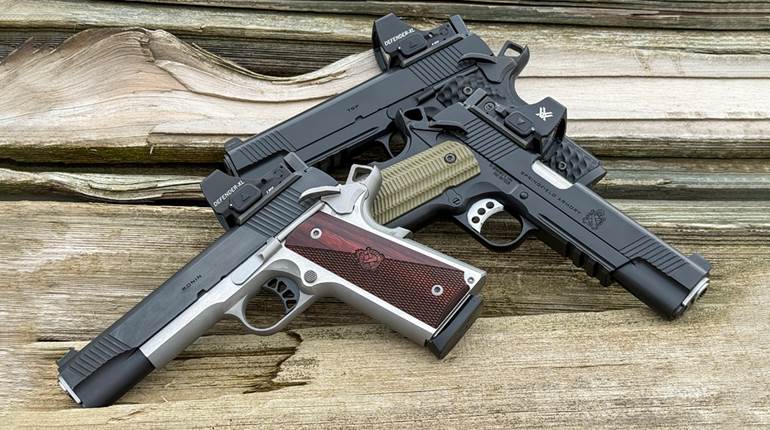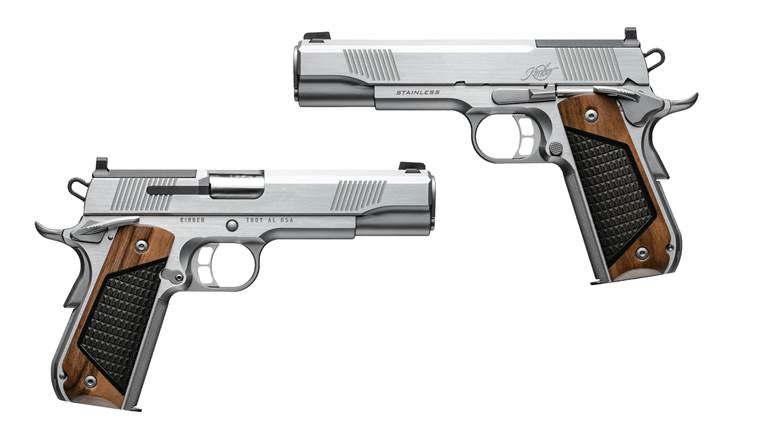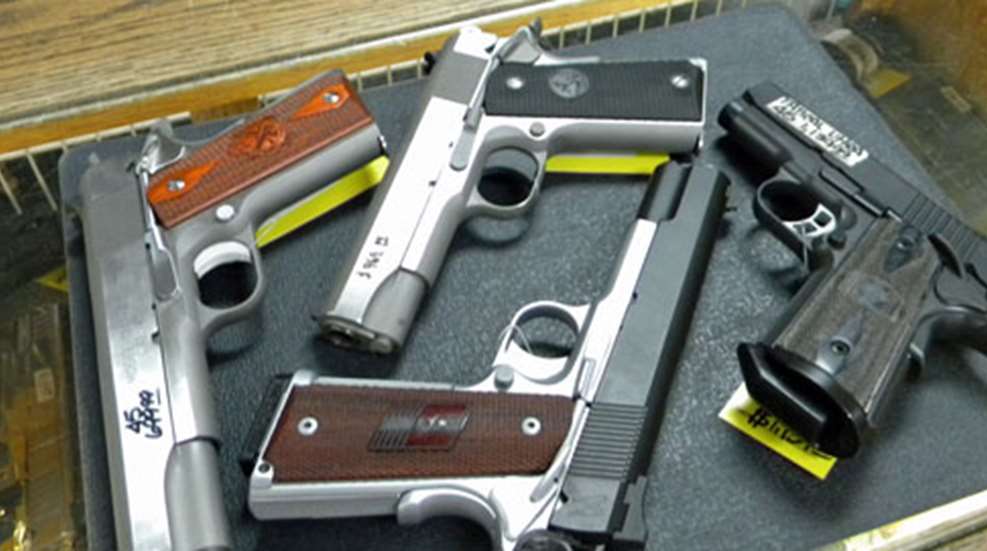
According to Jeff Cooper, the three requirements for a defensive pistol are that the pistol fits the hands, has a set of sights that can be seen and a crisp trigger. In the past, if you wanted a combat 1911 you sent a pistol to a gunsmith for modification, or placed an order for a custom build with one of the top gunsmiths like Ted Yost or Bill Wilson. Eventually, manufacturers picked up on the demand for modified 1911s and started offering “custom” factory pistols. Walk into your local gun shop and there will be a variety of factory-equipped 1911s at affordable prices. The key is to take this pistol, which is close to what you need, and modify it to fit you.
The best thing about the 1911 is it’s modular design, allowing almost anyone with a few tools and some basic knowledge to upgrade parts. If a gunsmith is required, it’s normally not very costly to have them install what you need.
Fit
The 1911 must fit your hand properly so you can operate the thumb safety, while depressing the grip safety and placing your finger in the proper position on the trigger. With a lot of handguns there’s some wiggle room with the grip. To operate a 1911 properly, most need to modify it to fit the hand.
The easiest modification is swapping out the stocks, or “grips,” which come in a variety of materials, textures and widths. The stocks need to fill your hand, while providing enough friction to control the pistol under adverse conditions. Don’t worry about what they look like. Focus on fit and function.
The thumb safety is another part to examine. Your thumb lives on top of the 1911’s safety, ready to depress it as you come on target. Placing the thumb underneath the safety can cause it to be bumped up, engaging it during recoil. When you come off target and engage the safety, the thumb goes back on top of the safety. Disengaging the safety every time you come on target should be habit, ensuring whenever you’re on target the pistol is ready to fire. The safety also works as a partial status check for the 1911. If the safety won’t engage, then the slide is out of battery and you have a problem to fix. You’re constantly manipulating the safety, so it needs to fit your hand.
Factory guns come with extended or oversize thumb safeties. The problem is the ledge or lip where your thumb rides is too high for most shooters, making it difficult to operate the safety efficiently while maintaining a proper grip. A low-mount safety, such as Brownells #340-100-044 or a Wilson #965-000-054, is the cure for this problem. The lowered ledge allows you to comfortably manipulate the safety, while maintaining the proper grip to depress the beavertail safety.
A slightly longer magazine release is also a good idea, regardless of hand size. Not an oversizedbutton, just something a little bit longer. You’ll still need to reposition the gun in your hand to hit the release, but the extended release makes this process just a little bit easier and ensures a positive release, especially if you’re using thicker stocks. Brownells’ #654-263-003 is a 1/16-inch longer than a standard magazine release and is usually a drop in part with no fitting required.
The 1911’s design, the angle of the grip in relationship to the barrel, makes it index on target naturally. Extend your arms forward with the hands, wrists and forearms in line and the sights easily index between your eyes and point of aim. But, if a little adjusting is necessary, change out the mainspring housing on the rear of the grip, which are available in flat, wedged and rounded shapes. The housing adjusts the angle of the muzzle and fills in behind the heel of the hand to create a better grip.
One of the major considerations to a proper fit is trigger length. To manipulate the trigger correctly your finger should be positioned so the center of the first pad is centered on the trigger. Our sense of touch is more acute in the center of the pad and you can feel the trigger as you manipulate it, which is the key to accuracy. The finger should be bent at the second or large joint forming an “L” shape. The movement as you press occurs in the large knuckle, pressing the trigger straight to the rear. Not enough finger on the trigger (the fingertip) or too much finger (wrapping it around the trigger) and you’ll push or pull the sights off target as you press.
The finger must be positioned properly on the trigger, as the heel of the hand depresses the grip safety. With small hands and a long trigger you have to wrap the hand too far forward to get on the trigger, which allows the beavertail safety to disengage-embarrassing on the range, ugly in a fight. If you have the proper grip to deactivate the safety but can’t index the finger on the trigger, your accuracy will suffer. The correct length trigger provides the proper grip and ability to manipulate the trigger efficiently.
Triggers are available in short, medium and long LOP (length of pull.) Most factory 1911’s come with a long trigger, while most shooters need a short trigger. I have small hands with short fingers, so I use a trigger with a 2-inch LOP, like Brownells’ #377-000-004.
The cool thing about changing triggers is that trigger, sear and disconnector are three separate pieces. Changing triggers doesn’t normally affect the action. Some fitting may be required to get the sufficient clearances needed for proper function, but a qualified gunsmith can help with this one.
Trigger
A major advantage of the 1911 is its single-action trigger. All the trigger has to do is release the hammer. The trigger moves straight to the rear, as opposed to pivoting at the top like most firearms. The trigger action and weight on most factory 1911’s will be better than a “mil-spec” pistol, but there is usually some room for improvement. Trigger pull, or weight, is a very personal preference but there are some things to consider. For example, my 1911 is for self-defense. Because of this, I use a 4.5-pound trigger. A lighter trigger might be fine for competition or target shooting, but under stress, a trigger that’s too light leads to shots to being fired prior to indexing the sights on target, or during follow through-recovering from the recoil and resetting the trigger. When this happens on the range it’s not a big deal. In a confrontation, you cannot afford errant rounds.
Sights
Defensive accuracy is defined by the situation. Most confrontations occur at close range against moving targets in low-light conditions. Quick combat-effective hits are the answer. If, however, all you can see of the threat is a small part of the body, you’ll need surgical type accuracy. Your sights must provide the ability to get fast multiple hits on close targets and surgical accuracy on small targets or at longer distances, under all type lighting conditions.
Keep in mind everyone’s eyesight is different. As we age it becomes more difficult to focus on the front sight, or to see it in low-light conditions. XS Sight Systems’ Express Sights with tritium work well for me. The round front sight is large and white with a tritium center in either a “standard” or “big” size. The rear sight is “V” shaped. The large front sight is good for quick acquisition and positioning the dot in the bottom of the “V” rear sight is natural. Tritium doesn’t help identify the threat, but being able to get a sight picture in the dark is a good thing.
Your rear sight should also have a lip that can be used to cycle the slide for when you’re injured. Be sure to experiment with different types under various lighting conditions.
Other Considerations
Do you need an ambidextrous safety? Or prefer the short stock type of guide-rods, which provide easier field stripping without special tools? Does your gun have a smooth or checkered frontstrap? All modifications have advantages and disadvantages.
The way some of them are designed creates a weak link that can be trouble. Always keep in mind that all modifications have advantages and disadvantages. Know both sides of the coin prior to making any changes, and if a modification doesn’t work, find what does.
I’ve been carrying the same 1911 for the last 15 years now. I spent about six years finding the ideal combination of parts and modifications. Now it literally feels like an extension of my body. It’s not very pretty, but it works every time and shoots more accurately than I can under realistic conditions.












